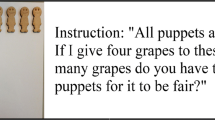Abstract
Comparing probabilities is a useful skill in life. Binary choice tasks are popular means in research on probabilistic reasoning. Falk, Yudilevich-Assouline, and Elstein (Educational Studies in Mathematics, 81(2), 207–233 2012) noted that many of these tasks contain design flaws. We designed and evaluated an extended and improved binary choice item set. In each trial, children were shown two boxes containing desired and undesired elements and had to identify the best box to blindly draw from. We took into account four necessary item set characteristics: (un)desired elements in the correct box, total number of elements in the correct box, and difference between desired and undesired elements in the correct box. Furthermore, some extensions to Falk et al.’s design (2012) were implemented: items in which one box certainly provided a desired element, items with three competing colors of elements, and items with lower “countability” of the elements. Results showed that extensions added to the design did not imperil internal consistency and validity. Younger children were more likely to give correct answers when the correct box contained more desired elements and older children are better at comparing probabilities than younger ones overall.




Similar content being viewed by others
References
Bryant, P. & Nunes, T. (2012). Children’s understanding of probability: A literature review (full Report). Nuffield Foundation.
Canizares, M. J., Batanero, C., Serrano, L., & Ortfz, J. J. (1997). Subjective elements in children’s comparison of probabilities. In E. Pehkonen (Ed.), Proceedings of the Conference of the International Group for the Psychology of Mathematics Education (vol. 2, pp. 49–56). Helsinki, Finland: University of Helsinki: Columbus, OH: Eric Clearinghouse for Science, Mathematics, and Environmental Education.
Denison, S., & Xu, F. (2014). The origins of probabilistic inference in human infants. Cognition, 130(3), 335–347.
Falk, R., Falk, R., & Levin, I. (1980). A potential for learning probability in young children. Educational Studies in Mathematics, 11(2), 181–204.
Falk, R., Yudilevich-Assouline, P., & Elstein, A. (2012). Children’s concept of probability as inferred from their binary choices—revisited. Educational Studies in Mathematics, 81(2), 207–233.
Fontanari, L., Gonzalez, M., Vallortigara, G., & Girotto, V. (2014). Probabilistic cognition in two indigenous Mayan groups. Proceedings of the National Academy of Sciences, 111(48), 17075–17080.
Girotto, V., Fontanari, L., Gonzalez, M., Vallortigara, G., & Blaye, A. (2016). Young children do not succeed in choice tasks that imply evaluating chances. Cognition, 152, 32–39.
Green, D. R. (1991). A longitudinal study of pupil’s probability concepts. In Proceedings of the Third International Conference on Teaching Statistics (vol. 1, pp. 320–328). The Hague, the Netherlands: Isi Publications in Statistical Education.
Hoemann, H. W., & Ross, B. M. (1971). Children’s understanding of probability concepts. Child Development, 221-236.
Piaget, J., & Inhelder, B. (1975). The origin of the idea of chance in children. Norton, New York: Routledge (Original work published 1951).
Prenzel, M., Baumert, J., Blum, W., Lehmann, R., Leutner, D., Neubrand, M., … Schiefele, U. (2004). PISA 2003: Der bildungsstand der jugendlichen in Deutschland - Ergebnisse des zweiten internationalen Vergleichs. Munster, Germany: Waxmann Verlag.
Siegler, R. S., Strauss, S., & Levin, I. (1981). Developmental sequences within and between concepts. Monographs of the Society for Research in Child Development, 46(2), 1–84.
Vlaams Ministerie van Onderwijs en Vorming (2010). Ontwikkelingsdoelen en eindtermen voor het gewoon basisonderwijs. [Attainment goals and standards for elementary education]. Retrieved from http://ebl.vlaandren.be/publications/documents/36473
Acknowledgements
This research was supported by the Grant KU Leuven project C16/16/001 “Development and stimulation of core mathematical competencies.”
Author information
Authors and Affiliations
Corresponding author
Ethics declarations
Conflict of interest
The authors declare that they have no conflict of interest.
Ethical approval
The study was approved by the social and societal ethics committee of KU Leuven (G-2016 07 591).
Informed consent
Informed consent was obtained from all parents of individual participants included in the study.
Additional information
Publisher’s note
Springer Nature remains neutral with regard to jurisdictional claims in published maps and institutional affiliations.
Rights and permissions
About this article
Cite this article
Supply, AS., Van Dooren, W., Lem, S. et al. Assessing young children’s ability to compare probabilities. Educ Stud Math 103, 27–42 (2020). https://doi.org/10.1007/s10649-019-09917-3
Published:
Issue Date:
DOI: https://doi.org/10.1007/s10649-019-09917-3




